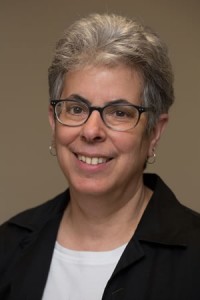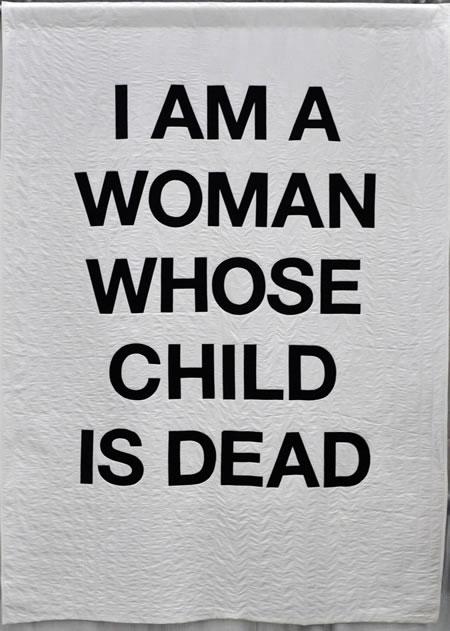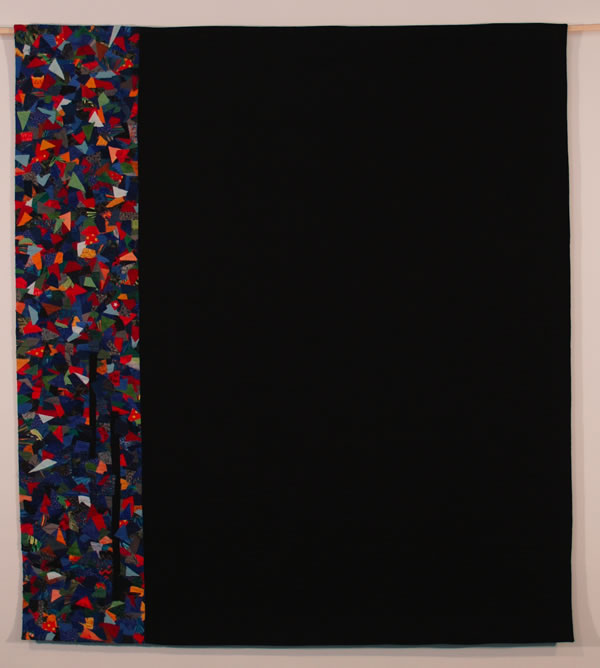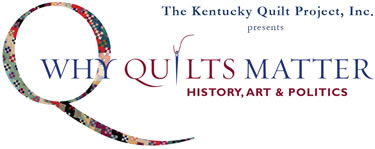Why Quilts Matter –
Question and Answer with Penny Gold, Part 1

Penny Gold
Editor’s Note: Followers of our Why Quilts Matter on Facebook know that we here at Why Quilts Matter – History, Art & Politics have been looking a variety of charity quilts, awareness quilts, and quilts made for specific causes. We were deeply moved by this story and wanted to share it with our readers in a two-part series. Our heartfelt thanks go to Penny Gold for sharing her story.
One of the most talked-about quilts at QuiltCon 2015 in Austin Texas was “Self Portrait, Year Two (Beneath the Surface)” by Penny Gold of Galesburg, Illinois. The quilt stirred very strong emotions. People stopped in their tracks; complete strangers openly weeping in front of each other and hugging, all because of what the quilt said, and how it made them feel. The remarkable black and white quilt had eight simple words with a not-so-simple message: “I am a woman whose child is dead.”
Guest Blogger Bill Volckening – Guest Blogger at Why Quilts Matter recently interviewed Penny Gold to learn more about her story. Here is Part I of the two-part interview.
When did you learn to sew and make quilts?
My mother taught me to sew when I was about 8 or 9; my first project was an apron, made on her treadle machine. My mother also taught me to embroider, knit, and crochet. I sewed simple clothing for many years, which is how I came to be comfortable with a sewing machine, though knitting was usually my craft of choice. I enjoyed looking at quilts, but never gave any thought to making them myself. It was not something my mother did, and learning from her was how I learned needlework. But in the spring of 2001, a friend’s daughter, whom I had previously taught to knit and sew, asked if I could teach her to quilt. Spurred by her interest, I checked out a pile of books from the public library and learned enough to begin. My first quilt was made jointly with her, a Cathedral Window quilt.
How many quilts have you made?
About 80 quilts, plus a number of smaller projects like placemats and table runners. About half of the quilts are small in size—baby quilts or wall hangings.
How has your quiltmaking evolved since making your first quilt?
Much as I was enjoying this new hobby, I was also frustrated by the greater challenges presented by quilting, and the many more choices compared to knitting; where I’d choose a pattern, select a color from the limited range of yarns available, and follow the directions. In quilting there are choices to make every step of the way, even when using a pattern. While my ability to use color, value, and shape improved through many small projects, I was very aware of how much I did not know about design, especially color and composition.
When did you make your first larger quilt?
In 2004, I had enough confidence to undertake a bed-sized quilt—a quilt for my son to take with him to college. We chose a log cabin design, in his favorite color, blue. Jeremy was to begin college in the fall of 2004, and I wanted the quilt finished by then. I had almost all the blocks done by the beginning of the summer.
And then Jeremy died.

Penny Gold – Self Portrait, Year Two (Beneath the Surface)
How did your son’s death affect your daily life?
For a week or so, the dark chasm that loomed on all sides was kept at bay by the round-the-clock presence of family and friends. But then I had to step back into the routine of life, and found it difficult. It was summer and I wasn’t teaching, so my days were unstructured by work.
Until my retirement in 2012, I was a professor of history at Knox College. The scholarly research I planned to do that summer was of no interest to me. Reading, which had always been a large part of my life, was also of no interest. One day it occurred to me that sewing might help me pass the time—the days were so long. I went over to the corner where I kept various projects, and found some small appliqué blocks that I had entirely forgotten about, all set to be stitched. It turned out this was just what I needed to help me through the day. The soft colors, simple shapes, and the hand-sewing itself were calming, and they kept my mind occupied in a way that helped keep at bay images of Jeremy’s accident and of his dead body.
The blocks were quickly finished, but I needed another project like it. The sewing was a kind of analgesic, almost an anesthetic. I lined up another project, this time going even further into the hypnotic effect of repetition by sewing again and again just one simple shape, a circle.
With these projects, the reason I was quilting had changed. It was not just a pleasurable pastime, resulting in gifts for friends, but something I needed to do for my sanity, that I needed to do to get through each day. And the resulting quilts were no longer something I could give away. I needed them by me.
What about the Log Cabin quilt you had started?
As I worked on the simple appliqué pieces, I also considered what to do about the log cabin quilt I had been making for Jeremy; how could I finish it, now that he was no longer here to receive it? But how could I discard this quilt I had been making for him? I finally thought of a way that I could finish it, embedding in it my grief. At the time Jeremy died, I had only three blocks left to complete the forty-eight that would make up the top.
I decided to change the design for the last three blocks, making them off of a five-sided center, rather than off the four sides of a square. When set into the diamond pattern Jeremy had chosen, it expressed for me the way in which his life had so abruptly gone off course. I thought a lot about where to put the three last blocks. I put them together rather than scattered through the quilt; towards the edge rather than in the center; towards the bottom rather than the top; catching the eye, but not dominant.
Did that quilt influence your approach to quilting?
I didn’t realize its significance at the time, but the decision to alter the log cabin block to carry personal meaning turned out to be good preparation for the workshop that would change my life. In June 2005, I attended a week-long design workshop with Bill Kerr and Weeks Ringle. Many quilting workshops focus on technique, with students replicating a quilt designed by the teacher. In contrast, the workshop with Weeks and Bill taught a design process, rather than a specific technique or pattern. My hope was that learning more about design principles would help me in the innumerable choices of quilting.
How did you get ready for such an intense experience?
To prepare for the workshop, we were supposed to come up with three possible ideas—memories of events, things we’d like to do in the future. These prompts didn’t work for me, so I turned to something else of interest—the late winter midwestern landscape. But then it got to be June, Design Camp was a week away, and I realized I was bringing with me only one idea, not the three they had asked for. The weekend before the workshop, my husband David and I went to a nearby state park to get away for a few days. We had lots of time to talk, including sharing how bleak the future seemed to both of us. At one point in the weekend, feeling the press of needing to come up with a third idea for the workshop, I asked David for help. It immediately occurred to both of us that our feeling of the future without Jeremy was something that could be the central idea for a quilt. As we talked, thinking together of a possible design, I sketched out our ideas—a mosaic of colors on the left, which would represent the brief span of Jeremy’s life with us, and a chasm of unbroken black on the right, representing our future without him.
What happened when you got to the Design Camp?
I arrived with two ideas, high expectations, a good deal of fear, and uncertainty about what direction I would be taking with a quilt. What I didn’t know was the extent to which this workshop would be a transformative event in my life.
One of the exercises was to create a portrait, using color in an abstract way to represent a particular person. There it was, an open door inviting me to work on a portrait of Jeremy, something that could be the base for the multi-colored strip in the sketch David and I had come up with.
How did you put it together?
The portrait was made with small scraps of fabric and came to me spontaneously, without a struggle. It put something of Jeremy’s character, and about how I felt about him, into a visual form. The choices of colors and shapes came easily because I had in mind the central idea I wanted to express: that it was about Jeremy, about his energy and intensity, about his sharp edges, about the problems as well as the joys; that his life was varied, but also limited.
With the maquette of the mosaic side of the quilt already done, the rest of the design came readily, putting the color of Jeremy’s life next to the blackness of our future. There were still many questions of size, scale and method. In the past, I would have been frustrated by so many decisions—frustrated that I didn’t know the “right” answer. But with this project, I felt entirely different. I was content to just keep at it until I had a method that felt right.
How would you describe the design process?
In all the quilting I’d done previously, I’d begun with a design made by someone else. For each of the subsequent decisions: fabric, color and value, border, binding, quilting—for each of these I had only the guidance of wanting to make something that would look nice, perhaps even beautiful. But now I had begun a quilt with an idea of my own, an idea about which I cared deeply. For every decision I faced, I had this idea to guide me. It wasn’t a question of what “looked best,” but of what best conveyed the idea I wanted to express.
What lasting impact did the Design Camp experience have on your work?

Penny Gold – Loss (front)
This principle of using a essential, originating idea as a generative source for a work of art of course was central to the design workshops taught by Weeks and Bill, a principle that applies elsewhere as well—writings by Twyla Tharp, the choreographer, have been helpful to me, as well as Roger Sessions on musical composition.
In the process of making the quilt (titled “Loss”), my reasons for quilting changed again. I still had pleasure in doing the handwork. And it still helped me to live with grief. But designing and making this quilt also brought out into the world the expression of something I felt, something for which words were inadequate, despite months of intensive journal writing.
Bill Kerr and Weeks Ringle also contributed to a change in my identity from scholar to an artist. When I returned home from the 2005 workshop, I changed my study to a studio. (You can read further thoughts on the change here.)
I have been lucky to extend the influence of these workshops over subsequent years. A number of the participants are from the Chicago area, and I live only three hours from there, making it possible for us to get together a couple of times a year; we also are in regular communication by e-mail. Being able to share my work in progress with these people who know me well and have the common grounding of Design Camp has been a tremendous help.
Also, on several occasions Bill has been able to come to one of our gatherings, providing an opportunity for individuals who want some guidance on their work to engage him for a consultation. His comments on and suggestions for my work have been crucial to my development as an artist. I am profoundly grateful to both Bill and Weeks for the shaping role they have had in my life. They are extraordinarily gifted and generous teachers.
Next up: Part 2 with Penny Gold where we learn about the process of designing and constructing the quilt, Self Portrait, Year Two (Beneath the Surface) – coming in June, 2015.
More about Penny
Penny Gold received a Ph.D. in History from Stanford University, and taught history at Knox College for 36 years, until her retirement in 2012. She lives in Galesburg, Illinois, with her husband David Amor. Their son, Jeremy Gold Amor, died on July 17, 2004. Penny’s blog may be found at Studio Notes.
Photos are courtesy of Penny Gold.


